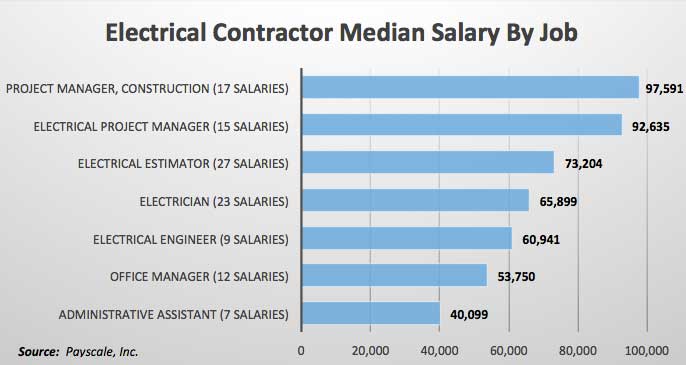What Electrical Contractors Earn



November 21, 2022 The Canadian Renewable Energy Association (CanREA) would like to indicate that Hydro-Québec’s Electricity Supply Plan 2023-2032, filed yesterday with the Régie de l’Énergie, is a step in the right direction and that the wind, solar and energy storage sectors will be able to supply a major portion of future energy needs. Quebec will be…

Supported by the U.S. Department of Energy, Pacific Northwest National Laboratory (PNNL) conducted research to characterize the current state of DC lighting and building microgrid market and technologies.

In 2018, the Canadian Electrical Code (CE Code) was revised so that liquid-tight flexible metal conduits (LFMC) and fittings used in certain hazardous locations are required to be “heavy-duty” (HD) certified.

Part 1 of this 4-part series examined the current state of this interplay in four major performance areas for high performance buildings (HPBs): healthy and productive, safe and secure, cost-effective, and functional and operational. Part 2 examines emerging considerations…

Industrial electricians have a clear advantage in payscale over other sectors of the industry, while residential electricians’ median salary is $4,000 below the national average.

Part 1 presented findings from a review of possible health risks of LEDs, conducted by the European Commission’s Scientific Committee on Health, Environmental and Emerging Risks.

November 21, 2022 The Canadian Renewable Energy Association (CanREA) would like to indicate that Hydro-Québec’s Electricity Supply Plan 2023-2032, filed yesterday with the Régie de l’Énergie, is a step in the right direction and that the wind, solar and energy storage sectors will be able to supply a major portion of future energy needs. Quebec will be…

Supported by the U.S. Department of Energy, Pacific Northwest National Laboratory (PNNL) conducted research to characterize the current state of DC lighting and building microgrid market and technologies.

In 2018, the Canadian Electrical Code (CE Code) was revised so that liquid-tight flexible metal conduits (LFMC) and fittings used in certain hazardous locations are required to be “heavy-duty” (HD) certified.

Part 1 of this 4-part series examined the current state of this interplay in four major performance areas for high performance buildings (HPBs): healthy and productive, safe and secure, cost-effective, and functional and operational. Part 2 examines emerging considerations…

Industrial electricians have a clear advantage in payscale over other sectors of the industry, while residential electricians’ median salary is $4,000 below the national average.

Part 1 presented findings from a review of possible health risks of LEDs, conducted by the European Commission’s Scientific Committee on Health, Environmental and Emerging Risks.

November 21, 2022 The Canadian Renewable Energy Association (CanREA) would like to indicate that Hydro-Québec’s Electricity Supply Plan 2023-2032, filed yesterday with the Régie de l’Énergie, is a step in the right direction and that the wind, solar and energy storage sectors will be able to supply a major portion of future energy needs. Quebec will be…

Supported by the U.S. Department of Energy, Pacific Northwest National Laboratory (PNNL) conducted research to characterize the current state of DC lighting and building microgrid market and technologies.

In 2018, the Canadian Electrical Code (CE Code) was revised so that liquid-tight flexible metal conduits (LFMC) and fittings used in certain hazardous locations are required to be “heavy-duty” (HD) certified.

Part 1 of this 4-part series examined the current state of this interplay in four major performance areas for high performance buildings (HPBs): healthy and productive, safe and secure, cost-effective, and functional and operational. Part 2 examines emerging considerations…

Industrial electricians have a clear advantage in payscale over other sectors of the industry, while residential electricians’ median salary is $4,000 below the national average.

Part 1 presented findings from a review of possible health risks of LEDs, conducted by the European Commission’s Scientific Committee on Health, Environmental and Emerging Risks.

March 31, 2025 By Blake Marchand Late last year Trilliant announced partnerships with Oshawa Power and Milton Hydro to enable suite metering and advanced metering technology using their Smart Building Platform. Those partnerships were the jumping off point for my conversation with Steven Lupo, Managing Director, North America at Trilliant, a company with four decades of innovation in Canada… Read More…

During my visit to ABB’s facility in Pointe-Claire, dubbed T-CAN after its location alongside the Trans-Canadian highway, I saw firsthand how automation is shaping the future of manufacturing. Read More…

March 28, 2025 By Electro-Federation Canada One key aspect of EFC is our value proposition for members. Years ago, when we re-branded EFC, our members articulated the reasons why they joined and ‘Grow. Lead. Compete.’ encapsulated the essence of what it means to be a member of our organization. It is not just a slogan; it is… Read More…

As a major representative of the electrical and automation industry, Electro Federation Canada remains committed to supporting its members and the industry overall in navigating the complexities of international trade policies. Read More…

March 28, 2025 Guided by Building the Workforce for a Growing Economy: the Saskatchewan Labour Market Strategy, the Ministry of Immigration and Career Training is investing more than $117.0 million in programs and services. “We continue to make training available for Saskatchewan people to prepare for the record number of jobs being created by our growing… Read More…

March 28, 2025 Three teams are advancing to the next stage of procurement for the new Skilled Trades and Technology building for the Saskatchewan Polytechnic, Joseph A. Remai Saskatoon Campus. Upon procurement completion, the successful proponent will be awarded the design and construction of the new Trades building under a Design-Build agreement. “This project is… Read More…

March 28, 2025 The New Brunswick government has introduced legislative amendments to improve labour mobility and reduce interprovincial barriers. “With potential tariff-related disruptions and an uncertain economic climate, workers and businesses need the ability to adapt quickly to quickly changing circumstances,” said Jean-Claude D’Amours, acting minister of post-secondary education, training and labour. “A flexible and… Read More…

March 28, 2025 The New Brunswick provincial government will end its Electric Vehicle Incentive Program on July 1. “This rebate program made it possible for many New Brunswickers to buy an electric vehicle during their introduction to the market, and is helping reduce greenhouse gas emissions,” said Finance and Treasury Board Minister René Legacy, who… Read More…
This project is funded [in part] by the Government of Canada.
Ce projet est financé [en partie] par le gouvernement du Canada.
